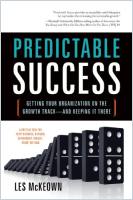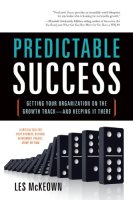
Why did I choose this resource?
I chose this resource to understand what predicable success is and how to achieve it.
What did you learn from it?
I learned the stages to achieving predictable success as well as how to maintain it. I also learned the actions to avoid entering the decline stages.
Key Knowledge
- Predictable Success – the point at which an organization dependably realizes its goals
- Growth Stages
- First Growth Stage: “Early Struggle”
- first three years
- establish a market for your product/service
- evaluate progress toward establishing a market at the end of every workday
- discover where your customers are
- constantly alter your product to learn what your customers are fond of
- be open to modifying your companies business plan, strategy, and “core values”
- Second Growth Stage: “Fun”
- business booms, rapid growth
- concentrate on selling to the market
- state of change, extreme flexibility
- Third Growth stage: “Whitewater”
- systems and processes
- hire first-rate operations manager
- unite sales and operations, create a new company structure
- “Predictable Success”
- Decision making
- Goal setting
- Alignment
- Accountability
- Ownership
- First Growth Stage: “Early Struggle”
- Decline Stages
- First Decline Stage: “Treadmill”
- too many systems and processes
- too much emphasis on “how” instead of “what”
- failure to grow
- employee complacency / frustrated management
- difficult to escape
- find a way to view your organization through different eyes
- Second Decline Stage: “The Big Rut”
- too much time spent in the “Treadmill” stage
- company leaders become complacent
- “visionary” employees leave
- company stifles creativity
- customers are viewed as an annoyance
- decisions made based on comfort
- escaped by major interventions
- Third Decline Stage: “Death Rattle”
- the point of no return
- organization fails due to
- major decline in resources
- refusal to evolve with technology
- customer abandonment
- First Decline Stage: “Treadmill”
- Approaching Predictable Success – Building a Machine for Decision Making
- Organization chart – who influences decision making
- Lateral management roles – develop relationship with other managers
- Alignment – employees actions reflect company goals
- Cross-functional teams – all departments must work harmoniously together
- Empowerment – team members trust and rely on each other
- Ownership and self-accountability – managers able to “pull” employees instead of “push”
- Returning to Predictable Success – Building “Dynamic, People-Oriented Systems”
- Hiring – from within and outside the company, be willing to move people laterally
- Deployment – explain to new workers why specific tasks are assigned to them
- Performance assessment – have a conversation with the employee
- Training – engage the new hire during training
- Mentoring and coaching – assign mentors laterally, trust is built
- Ownership and self-accountability – employees take ownership of their actions
How are you using what you learned?
I am using what I learned to gain a better understanding of where our company is on its road to predicable success and how to move forward.
Key Changes / Key Actions
- Create an organization chart
- Discover where the company is and create a plan to work towards predictable success
Source
- Name : Predictable Success
- Author : Les McKeown
- getAbstract.com: Link to Book

